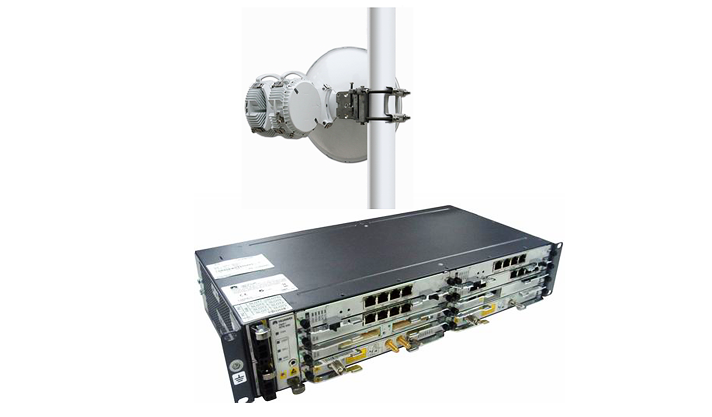Unified Platform for TDM/Hybrid/Packet, Meeting the Requirements of Network Evolution Towards All-IP Backhaul
Supports the processing and access of native TDM services, native Ethernet services, and PWE3 services.
Supports multi-mode microwave radio: Hybrid mode (E1+ETH), pure Packet mode, PDH mode, and SDH mode.
Provides packet-based IEEE 1588v2 clock synchronization, facilitating cost-effective clock solutions.
Large-Capacity and Broadband-Oriented Microwave Platform
Adopts highly efficient encapsulation and advanced header compression technologies, increasing the maximum capacity of one carrier to more than 1 Gbit/s.
Supports XPIC technology, doubling the capacity of one carrier to 2 Gbit/s.
Supports Air-LAG.
All channels and frequencies have hitless switching from QPSK to 1024QAM with Adaptive Modulation (AM).
Priority levels can be set for native E1 services and packet services.
Multi-directions and Network-Oriented Nodal Equipment
Supports convergence of up to six RF directions.
Supports TDM cross connection and Ethernet switching.
Robust IP Service-Processing Capability
Supports E-Line or E-LAN services based on VLAN or QinQ, and supports E-Line services based on PW.
Supports basic MPLS functions and service forwarding, and supports static LSPs.
Adopts the LSP tunnel and PWE3 technologies to form an MPLS network, where multiple services can be accessed.
Supports 8-class QoS, provides a wide range of services, and ensures the quality of high priority services.
Supports EOS/EOPDH.
Supports ETH LAG.
Supports VLAN sub-interface.
Supports various OAM features, including Eth OAM, MPLS OAM, ATM OAM, and PW OAM. These features allow the management and maintenance in IP networks to be similar to that of SDH networks.
Complete Protection Schemes
Protection for radio links
1+1 HSB/SD/FD protection
N+1 protection
XPIC 1+1
Network-level protection
Ethernet Ring Protection Switching (ERPS) protection and MSTP protection
LAG protection for Ethernet services
MPLS 1:1 tunnel protection
TDM SNCP protection (including SDH link and radio link)
IMA protection for ATM over E1 services
Linear MSP and ring MSP
Equipment-level protection
1+1 hot backup for the power input, internal power modules
1+1 hot backup for control, switching, and timing boards
Easy Installation
The RTN 950 can be installed in any standard telecom cabinet, outdoor cabinet, or on a desktop/pole/wall.
The RTN 950 and wireless base station can share one cabinet.
Easy Maintenance
Supports different types of loopbacks at the service port and the IF port.
Supports RMON performance events and the MPLS OAM functions.
Supports MPLS OAM, IEEE 802.1ag, and IEEE 802.3ah.
Supports ITU-T Y.1731.
Supports ATM OAM.
Provides a built-in test system to perform the pseudo-random binary sequence (PRBS) error test at the E1 port and the IF port.
Provides a hot-pluggable CF card, which stores data configuration files and software. The CF card can be changed for data loading or software upgrade.
Supports remote data and software loading by using the NMS, which allows the entire network to be upgraded rapidly, enabling in-service software upgrades.
Multiple Methods for Network Management
RTN devices and Huawei optical transport devices are managed by the iManager U2000. The iManager U2000 enables fast fault locating and quick service provisioning, and achieves visual IP service management while reduce the OPEX.
Single or multiple RTN NEs are managed in a centralized manner using the Web LCT.
Users can query alarms and performance events through the simple network management protocol (SNMP).
Dedicated DCN channels are not required as the inband DCN scheme is used, reducing the network construction costs.

